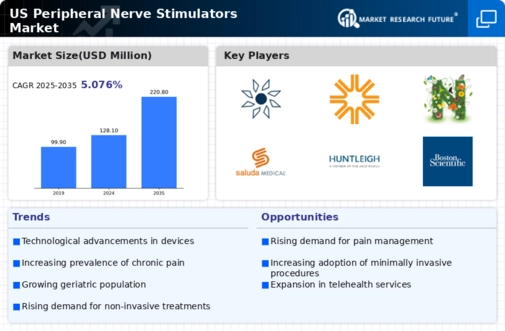Supportive Reimbursement Policies
Supportive reimbursement policies in the US are playing a crucial role in the expansion of the peripheral nerve-stimulators market. Insurance coverage for neuromodulation therapies is becoming more prevalent, which alleviates financial barriers for patients seeking these treatments. As reimbursement frameworks evolve to include peripheral nerve stimulators, more patients are likely to access these innovative therapies. This trend is expected to enhance market penetration and drive growth within the peripheral nerve-stimulators market. The alignment of reimbursement policies with clinical guidelines is likely to further solidify the position of peripheral nerve stimulators as a mainstream treatment option.
Technological Integration in Healthcare
The integration of advanced technologies in healthcare is significantly influencing the peripheral nerve-stimulators market. Innovations such as telemedicine, wearable devices, and mobile health applications are enhancing patient monitoring and treatment adherence. These technologies facilitate remote management of patients using peripheral nerve stimulators, allowing for timely adjustments and improved outcomes. The peripheral nerve-stimulators market is poised to benefit from this trend, as healthcare providers increasingly adopt integrated solutions that enhance the efficacy of treatments. This technological synergy is expected to drive market growth, as it aligns with the broader movement towards personalized and patient-centered care.
Rising Incidence of Neurological Disorders
The increasing prevalence of neurological disorders in the US is a primary driver for the peripheral nerve-stimulators market. Conditions such as neuropathic pain, multiple sclerosis, and Parkinson's disease are becoming more common, leading to a heightened demand for effective treatment options. According to recent estimates, approximately 1 in 6 adults in the US experience some form of neurological disorder, which translates to millions of potential patients. This growing patient population is likely to drive the adoption of peripheral nerve stimulators, as they offer a non-invasive alternative to traditional pain management methods. The peripheral nerve-stimulators market is thus positioned to expand significantly as healthcare providers seek innovative solutions to address these complex conditions.
Growing Awareness of Neuromodulation Techniques
There is a notable increase in awareness regarding neuromodulation techniques among both healthcare professionals and patients in the US. This growing recognition is fostering a more favorable environment for the peripheral nerve-stimulators market. Educational initiatives and outreach programs are helping to inform stakeholders about the benefits and applications of peripheral nerve stimulation. As a result, more patients are seeking these treatments for conditions such as chronic pain and migraines. The peripheral nerve-stimulators market is likely to see a rise in demand as patients become more informed and proactive about their treatment options, leading to greater acceptance of these innovative therapies.
Increased Investment in Pain Management Solutions
The peripheral nerve-stimulators market is experiencing a surge in investment aimed at developing advanced pain management solutions. As chronic pain affects nearly 20% of adults in the US, healthcare systems are prioritizing effective treatments that minimize reliance on opioids. This shift is prompting increased funding for research and development of peripheral nerve stimulators, which are seen as a viable alternative. The market is projected to grow at a CAGR of around 10% over the next five years, driven by this influx of capital. The peripheral nerve-stimulators market is thus likely to benefit from enhanced product offerings and improved patient outcomes as a result of these investments.

















Leave a Comment